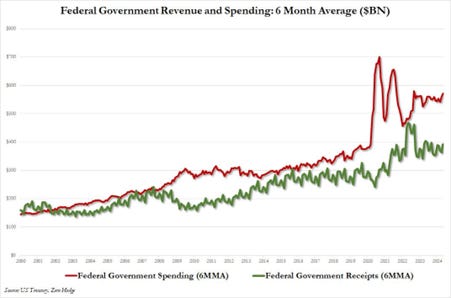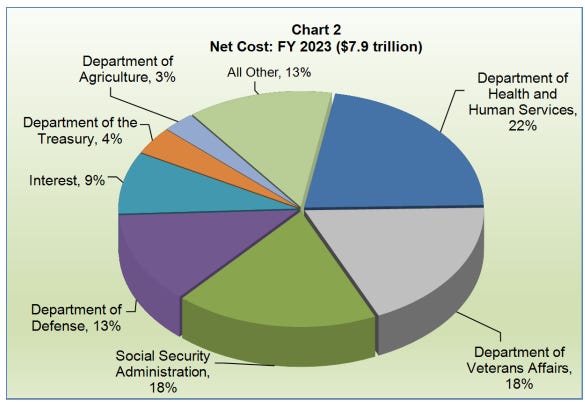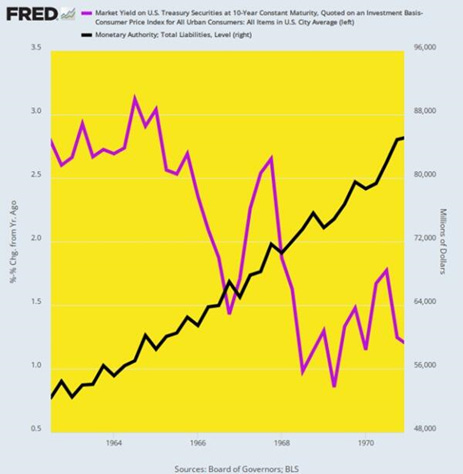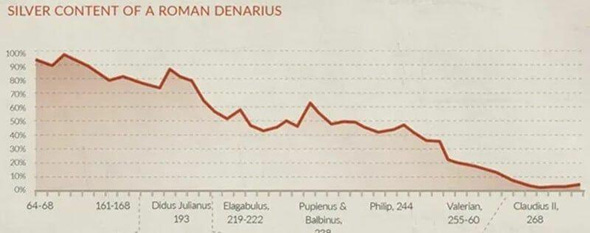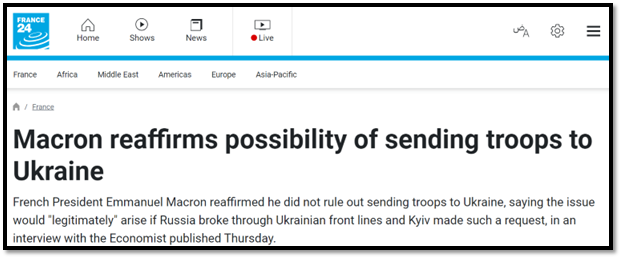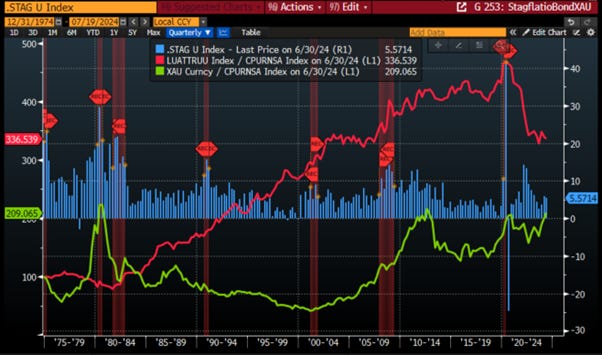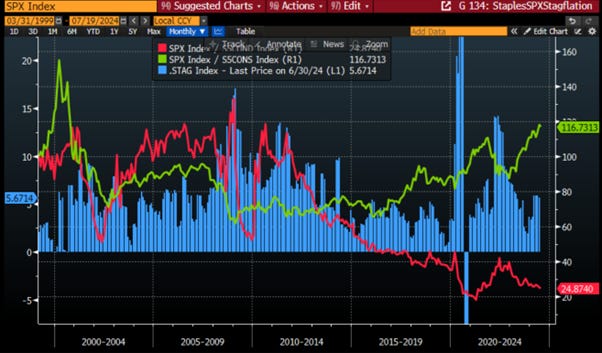Fiscal Dominance Steers Bankers' Wars
Unless investors would have been living under a rock since the start of Bidenomics, they know that over the past 3 and half years, the US government has been on a frenetic spending spree. The Keynesian communists in power have advocated that higher government spending will solve all the problems of an economy impacted by supply constraints and shortages, which are related to the ongoing proxy wars in Europe and the Middle East, as well as tighter regulations implemented by those who are religiously spreading the climate change scam as well as diversity and equality.
For the record, while on the surface, following four months of triple-digit deficits (in the billions), the June budget deficit of ‘only’ $66 billion was a pleasant surprise (especially when the market expected an $83 billion deficit, and it compares favourably to the $228 billion deficit a year ago). Indeed, the deficit was small enough that it managed to shrink the cumulative YTD deficit ($1.268 trillion) below the deficit for the comparable period one year ago ($1.393 trillion).
Unfortunately, that's as good as it gets because, when one takes a step back and ignores the monthly calendar effects, the picture remains the same: the US is spending far more than it is generating in tax revenues.
And it only goes downhill from there, because, as noted previously, the biggest risk factor is not so much spending on such discretionary items as social security, health, and national defence (‘how dare you say these are discretionary! These are mandatory, untouchable outlays,’ some will scream, but if and when the taxes dry up and the dollar loses its reserve status, you will see just how discretionary they are), but on interest.
Here investors must recall that interest on US debt, currently the second biggest government outlay at $1.1 trillion, will surpass social security and become the single biggest US expense before the end of 2024 at $1.6 trillion.
So where are we now? According to the latest Treasury Monthly Statement, in June the US spent a gross $140 billion on debt interest, bringing the YTD total to $868 billion, and is on pace to hit $1.144 trillion for the full year. This is a big number. How big? This was in fact the single biggest monthly interest outlay on record!
Putting it in context, the $140 billion in gross interest spending was just over 30% of all US receipts (mostly taxes) in June.
As quoted from an executive summary of a joint report by the Department of Treasury and the Office of Management and Budget (OMB), the current deficit policy is deemed unsustainable. However, they fail to mention how long the FED, via fiscal dominance, can sustain the unsustainable.
Fiscal dominance is a condition whereby the amount of debt in an economy reaches a point where monetary policy actions must allow federal debts and deficits to be serviced and funded cost-effectively. By default, such monetary policy decisions will often come at the expense of traditional employment and price goals. As a result, the FED must further distort the price of money and ultimately lessen the wealth of the US citizens.
Learning in the financial textbook, we know that a lender or investor should never accept a yield below the inflation rate. If they do, the loan or investment will reduce their purchasing power. Regardless of what should happen in an economics classroom, the FED has forced a negative real rate regime upon lenders and investors for the better part of the last 20+ years. Looking at the FED Funds less CPI it has been negative for most of over the past 20 years. In a nutshell, negative real FED Funds have become the rule, not the exception.
It's because the government is spending wildly, like so incredibly irresponsibly, that it's causing what we're calling fiscal dominance, meaning fiscal spending is dominating the FED's attempt to tackle inflation by raising rates. This has already caused localized recessions affecting people's finances, especially in commercial real estate and regional banks. The Federal Reserve and regional banks are actively collaborating to mitigate these economic challenges, focusing on stabilizing community banks to prevent further financial distress. Simultaneously, the sharp increase in interest rates has profoundly affected long-duration treasuries, historically considered ‘risk-free investments’. For instance, raising rates from 0.025% to 5.5% on a 30-year bond with a 1.5% yield significantly depreciates its market value over its remaining duration. This shift reflects a departure from the previously held belief that treasuries would reliably mature at par value, with accrued coupon payments. Previously, crises like the tech bubble and the housing market collapse primarily impacted banks, which then transferred the risks to the federal level. The COVID-19 ‘plandemic’ in 2020 prompted unprecedented government intervention, including the monetization of $6 trillion in debt, dramatically expanding the Federal Reserve's balance sheet to become the largest holder of treasuries globally. However as Fiscal Dominance is here to stay, the next crisis will inevitably a sovereign debt crisis.
In a recession, tax revenues plummet while spending surges due to social programs like unemployment and wage security. This mean that the current deficit could balloon the deficit from $2 trillion to potentially $3, $4, $5, or even $6 trillion annually. Such a debt spiral, where new debt issuance is needed to pay off existing debt, erodes confidence in US bonds and undermines the value of the dollar through inflation. This constant manipulation by central banks perpetuates a soft default scenario, where future dollar repayments are worth less than initially lent, driving the US into a cycle of increasing inflation and debt. The only apparent solution seems to be maintaining negative real interest rates on treasuries indefinitely to sustain nominal GDP growth, despite it being based on inflated values rather than real economic expansion. That's the only way they can keep this charade going. It won't go on forever. Make no mistake, this cannot go on forever and will end when the US Treasury is unable to issue more new debt to pay back the old debt.
In this context, central banking today masquerades as a form of Wall Street-pleasing monetary manipulation. It uses central banking terminology but undermines main street prosperity, benefiting the top 1% with substantial financial gains. In reality, nearly everything the FED does purportedly for the American economy is unnecessary and deceptive. The FED has become beholden to Wall Street traders and high rollers, operating largely at their direction.
Looking back at history, it shows that the US economy thrived for a decade between Q4 1951 and Q3 1962 without extensive FED intervention: the FED's balance sheet remained stagnant at $51 billion (black line), yet GDP grew from $356 billion to $609 billion, a 71% increase (purple line), largely driven by real output gains rather than inflation.
During the immediate post-Treasury-FED Accord period starting in March 1951, interest rates were allowed to find their own levels after WWII-era Treasury bill and long-bond pegs were lifted. The FED's balance sheet, which had ballooned from $12 billion to $51 billion due to war debt exigencies, marked an early form of indirect debt monetization. In contrast, the liberated FED allowed market forces to determine interest rates without the monthly guessing game on Wall Street. This period saw high growth, robust investment, strong wages, rising real family income, and minimal inflation, a benchmark for a successful capitalist economy without significant central bank intervention or money printing over an 11-year span.
Per Annum Change, Q4 1951 to Q3 1962
Real Final Sales: +3.8%.
Real Domestic Investment: +4.1%.
Nonfarm productivity growth: +2.5%.
Real hourly wages: +3%.
Real Median Family Income: +2.3%.
CPI Increase: +1.3%
Federal Reserve Liabilities, 1937 to 1962
During this period, the strong macroeconomic performance described wasn't unusual or random. President Eisenhower's sharp cuts in defence spending and elimination of the fiscal deficit in his second term meant the public debt only increased by $30 billion, just 0.6% of GDP. This increase, mainly from early Korean War borrowing, wasn't offset by FED bond-buying but financed through private savings in the bond markets. Long-term bond yields rose from the pegged 2.5% to about 4% by the period's end, driven by market forces. Despite this, CPI averaged just 1.2% during 1959-1962, resulting in real yields nearing +3.0%. Unlike recent decades, the FED didn't push real rates to zero or negative, yet main street economy thrived with solid returns for savers and investors.
Long-Term US Treasury Bond Yield, 1942 to 1962
The benign economic conditions of 1951 to 1962 came to an end due to escalated War Finance during the Vietnam War under President Lyndon B. Johnson (LBJ) who dramatically succeed to John Fitzgerald Kennedy (JFK) who was again the war in Vietnam. As the debt soared, 10-year US Treasury yields climbed to nearly 6% by early 1968. LBJ, unwilling to let market interest rates fund his Great Society initiatives, pressured the FED Chairman to lower the federal funds rate. This accommodative policy was driven by a federal deficit that grew significantly from 1963 to 1968, exacerbating inflationary pressures. Despite earlier FED efforts to raise rates in response to growing deficits, rates were swiftly reduced in mid-1967, leading to speculation and inflation. The CPI surged from 1% year-on-year in August 1964 to a peak of +6.4% in February 1970. This marked a significant shift as the FED's previously stagnant balance sheet began aggressive expansion, rising from $52 billion to $85 billion between Q3 1962 and Q4 1970, setting a precedent for future balance sheet expansions. The first casualty was, of course, inflation-adjusted bond yields (purple line). As depicted, the healthy +3% real yield of 1962 plummeted to barely +1% by the end of 1970. The decline in inflation-adjusted bond yields from a robust +3% in 1962 to barely +1% by 1970 marked the initial impact. However, the critical essence of this "guns and butter" breakdown cannot be denied. Namely, the FED's first round of post-war money printing and debt monetization was not driven by a mysterious economic downturn or failure requiring intervention from the central bank. On the contrary, this was a Washington-driven departure from sound central banking practices, plain and simple. This marked the beginning of rogue central banking. Once the inflation genie was unleashed, with the CPI hitting 6% by the fall of 1970, the FED struggled for over a decade to contain it. Consequently, any emphasis on stimulating growth, jobs, housing, and investment became sporadic and clearly took a back seat to the fight against inflation.
Inflation-Adjusted Yield on 10-Year UST Versus Fed Balance Sheet Growth, 1962 to 1970
Despite facing four recessions (1970, 1975, 1980, and 1981) and minimal support for growth from an inflation-focused FED, the US economy still managed to expand reasonably well from Q4 1969 to Q2 1987. Economic growth, measured by real final sales, averaged a solid +3.1% annually, driven by the inherent growth dynamics of private capitalism despite occasional monetary tightening. During this 17.5-year period, chaired by Burns, Miller, and Volcker, the FED's primary focus remained on inflation control rather than stimulating growth. While job growth, productivity, and real median family income did not excel, they also did not collapse into economic turmoil. Clearly, these outcomes on main street were driven by market capitalism, not central bank interventions. Throughout most of the period, the central bank was focused heavily on combating inflation. This absence of central bank ‘help’ further proves that easy money stimulus is not essential for robust growth and main street prosperity.
Per Annum Change, Q4 1969 to Q2 1987
Real Final Sales of Domestic Product: +3.1%.
Labor hours employed: +1.5%.
Nonfarm productivity: +1.8%.
Real Median Family Income: +1.2%.
The FED's repeated anti-inflation efforts led to significant volatility in the funds rate, resembling a monetary jumping bean. Leading up to each of the four recessions marked by shaded areas in the graph, the increases in the Fed funds rate were as follows:
1970: +340 basis points.
1974: +960 basis points.
1980: +1,290 basis points.
1981: +440 basis points.
Undoubtedly, these successive rate-raising campaigns inflicted severe damage on the main street economy. The violent swings in interest rates and the resulting start-and-stop economic cycles, culminating in four recessions within just 17 years, were far from conducive to growth during an era of high and volatile inflation. The reasonably solid macroeconomic performance can be seen as a baseline of free market resilience. It reflects the relentless efforts of workers, consumers, entrepreneurs, businessmen, investors, savers, and speculators to improve their economic circumstances, despite inflationary challenges and financial manipulation by the central bank aimed at controlling inflation.
Federal Funds Rate, August 1968 to June 1987
The inflationary challenges were indeed substantial, far exceeding any prior peacetime experience. Compared to the 1.3% average inflation from 1951 to 1962, the CPI rose at a rate of 5.6% from 1969:4 to 1987:2, even with the sharp decline in inflation engineered by Paul Volcker in the final four years of that period. During the 1970s, leading up to the inflation peak of 14.6% in April 1980, the CPI increased by an average of 7.7% annually. This era introduced the working class to rapidly rising nominal wage rates, which were largely eroded by sharply increasing consumer prices. Over the decade ending with the inflation peak in Q2 1980, nominal average hourly earnings grew by 7.6% annually, yet workers' real wage gains averaged only 1.1% per year during the same period, after accounting for inflation.
Y/Y Change in the CPI, 1960 to 1987
If the wage-price treadmill effect since 1969 was the main issue, it might have been deemed manageable. Market capitalism showed resilience against inflationary pressures and the FED's harsh anti-inflation measures. However, two detrimental outcomes emerged from the 1970s inflation era. Firstly, it shifted the central bank's role from liquidity provider at market rates to managing inflation rates, a stark departure from its original mandate under the gold standard. This shift led to the modern era of macroeconomic management embedded in inflation indices like CPI and PCE deflator. Secondly, the era saw a surge in unit labour costs, triggering extensive offshoring of the US industrial base. In retrospect, maintaining the principles of high growth, low inflation, and market-driven interest rates, as advocated during William McChesney Martin's tenure, would have been preferable. Instead, the FED's balance sheet expanded drastically during the high inflation decade, contrary to Martin's era of stability. Under the three successive Chairmen, the FED’s balance sheet grew at the following compound annual rates:
Arthur Burns (Feb. 1970 to March 1978): +6.9%.
William Miller (March 1978 to August 1979): +9.5%.
Paul Volcker (August 1979 to August 1987): +6.8%.
Growth Lift-off of Federal Reserve Balance Sheet, Q1 1970 to Q2 1987
While many may think this historical flashback is not important for today’s investors, fast forward to 2020, the US government has added $2.5 trillion in debt over the last four quarters. Of that, over $1 trillion was to pay its interest expenses on the entire debt stock. Despite recent high interest rates, the average interest rate on the debt is still relatively low at 3.06%. The relatively minimal uptick in the average interest rate on the debt is so troublesome. The federal debt has grown by 8.5% annually over the last ten years. Despite the amount of debt more than doubling over the period, the interest expense on the debt until very recently has remained very low. Indeed, the average interest rate increase is barely visible.
As debt issued years ago with low interest rates matures and new debt with higher interest rates replaces it, the interest expense will keep rising. For the context, if we assume the government’s average interest rate is 4.75%, likely close to their weighted average rate on recent debt issuance, the interest expense will rise to $1.65 trillion, not including new debt. $1.65 trillion is over $300 billion above the government’s next largest expenditure, Social Security. Furthermore, it is double defence spending for 2023. The annual federal deficit has only been above $1.65 trillion twice (2020 and 2021) since its founding in 1776. While the situation may sound gloomy, one solution would be to lower interest rates. If interest rates return to the levels existing before 2022, the interest expense could easily fall below $700 billion, about half of the cost if rates remain at current levels. This means that the FED could be forced by the political power to lower interest rates one way or the other.
In 2008, Ben Bernanke said QE was a temporary measure that would be reversed once the economy and markets returned to normal. Trillions worth of Treasury purchases later, it should be clear that QE and shadow liquidity injections are permanent rather than temporary.
In 2024, the government is by far the largest borrower, rendering interest rate hikes ineffective as it simply borrows more, beyond the control of central banks. Historical examples, like the Federal Reserve's refusal during the Korean War in 1951, highlight conflicts over monetary policy when the budget isn't balanced. Quantitative Easing undermined the Keynesian model, leaving central banks with few tools to manage the economy. Government spending continues unchecked, fuelled by unsustainable borrowing, leading to an impending Sovereign Debt Crisis. The inability of Keynesian economics to adapt to declining confidence in government and the economy suggests a need for new approaches to understanding economic cycles, including factors like geopolitical tensions, which interest rate adjustments alone cannot sustainably manage.
In the current government's debauchery (wars and taxation), whether right or left, they’re going to point their finger and blame the FED as politicians will never take responsibility for their failures.
Seasoned investors know that governments, by nature, spend too much, as history is full of examples of governments desperately trying to finance their mountains of debt. Debt brought down Rome, first with hyperinflation, then with a gutted military that barbarians walked right over. It brought down Spain, as New World gold financed an effective government takeover of the private sector. And France was bankrupted by financing foreign wars, in this case, the American Revolution. The Qing Dynasty collapsed under debt, and even Great Britain, which owned half the earth for nearly a hundred years, faced the consequences of debt. To this day, government debt crashes countries. Nations from Turkey to Venezuela to Nigeria are currently undergoing debt crises, with Argentina desperately trying to pull out of one.
In 2024, with the US government ruled by warmongering plutocrats, the amount of money spent on foreign aid, wars, the intelligence community, and other aspects of foreign policy is enormous and continuously increasing. This accelerating trend is approaching a breaking point and most investors are still unprepared for what lies ahead.
This brings us to why wars historically have been used by plutocrats in power to divert public attention from real internal problems and as a way for governments to ultimately default on their debts. Western mass media and the plutocrats in power across the Western world proclaim that the war in Ukraine is about stopping Russian aggression. However, as informed readers may already know, this war is a neocon-sponsored conflict aimed at justifying the current Fiscal Dominance regime which has been initiated to finance regulations founded on the climate change scam and the diversity equality narrative which are part of the globalist agenda of the one world government. Russia, like many countries in the Global South, opposes the globalist agenda centred around multinational control by a small group of plutocrats. Indeed, western corporations had already exerted control over Ukraine; when the war began, these corporates seized farmland and factories. Western billionaires invested billions of dollars and loaned substantial sums to Ukraine's now illegitimate president. These loans are unlikely to ever be repaid; if they are, it will likely be with state assets. This reality has been obscured by Western mass media, but maverick US presidential candidate Robert F. Kennedy has clearly explained this situation to those who can see beyond the curtain. The supposed aid packages to support Ukraine in its conflict with Russia are, in reality, a massive money laundering scheme designed to enrich US weapon manufacturers and their shareholders.
The plutocrats label it as a loan to Ukraine, imposing conditions such as extreme austerity measures and requiring Ukraine to sell off all government-owned assets, including its vast agricultural land, known as the ‘Bread Basket of Europe’. Last December, President Biden awarded the contract to rebuild Ukraine to BlackRock once the war concludes. This strategy by the deep state aims to keep divisions among 'We The People,' fostering conflict and profiting from loans and access to resources. The recent controversy over $300 billion in seized Russian assets in the West is not explained to the public, while Russia has frozen nearly half that amount of Western assets in retaliation. If Russia seizes Ukraine, Western governments and corporations risk losing investments and billions in unpaid loans. This explains the panic among Western leaders. Indeed, Ukraine has partnered with BlackRock and JP Morgan to form the Ukrainian Development Bank for reconstruction, funded by Western taxpayer money.
https://www.kmu.gov.ua/en/news/minekonomiky-oholosylo-podrobytsi-stvorennia-fondu-rozvytku-ukrainy
This plot was recently confirmed by Lindsay Graham, a prominent member of the Washington deep state known for his neoconservative views, that a primary objective of the ongoing war in Ukraine is for US corporations to gain control over 10 to 12 trillion dollars' worth of critical minerals located in the country.
The ongoing war in Ukraine, much like other wars, appears to have deep economic roots driven by financial interests. In World War I, despite the war stalemating in 1916, bankers who had loaned substantial sums to Britain and France sought to prolong the conflict. Their aim was to ensure that Germany's defeat would enable them to demand reparations, thereby securing repayment with interest. This manipulation extended the war until the United States intervened, allowing bankers to collect their loans. However, this economic exploitation contributed to political and economic instability in Germany, ultimately leading to World War II. John Pierpont Morgan, leveraging his close ties with British Ambassador Cecil Spring Rice, ensured that his firm, J.P. Morgan & Co., served as the official purchasing agent for the British government during World War I. This role involved buying essential materials like cotton, steel, chemicals, and food, earning a commission of 1% on all purchases. Morgan further organized a syndicate of 2200 banks to float a $500,000,000 loan to the Allies, with his firm exclusively handling munitions and supplies purchases, generating significant profits.
Looking back further into history books, the Rothschilds, the iconic banking family which started its banking dynasty with Mayer Amschel Rothschild who was a key figure in the Napoleonic wars. The Rothschilds built a significant fortune before the Napoleonic Wars and became leaders in the bullion trade. Nathan Mayer Rothschild financed the British war effort from 1813 to 1815, organizing bullion shipments to Wellington's armies and arranging subsidies to Britain's allies in 1815. The Rothschild brothers coordinated their activities across Europe, creating a network of agents and couriers to transport gold. This network provided Nathan with early news of Wellington's victory at Waterloo, which he first relayed to the government. Anticipating a post-war economic bounce, Nathan bought British government bonds and sold them in 1817 for a 40% profit.
Fast forward back to today, in essence, Ukraine owes the West $300 billion in loans it cannot repay unless it sells state assets to Western interests. If Russia wins the war, Ukraine faces potential dissolution as a country, rendering these loans unrecoverable. Western banks and governments, managed by JP Morgan Chase Bank, which historically managed debts including those from World War I, would then be compelled to write off massive debts tied to Ukraine. This explains why most leaders in the West, under the pressures of their bankers like during World War I are now talking of sending troops on the ground. Notably, among Western leaders, President Macron, a former investment banker, has been particularly bellicose, reflecting his background and alignment with globalist interests in this context.
Ultimately, investors know how this will end. When investors stop buying government debt, governments are shut out, leading to massive austerity and soaring inflation as they retrench. Historically, governments cancel the trillions they promised, starting with Social Security and Medicare, then pull back to where they can only pay the Praetorian Guard and not much else. In short, once debt hits the critical point, Washington goes from Sugar Daddy to a wild animal. And, historically, this shift happens much faster than people imagine, in Hemingway’s famous phrase, you go bankrupt gradually, then all at once.
Ultimately, investors must remember that war is a great distraction set up by those in power to enrich their plutocrats and that ‘The difference between war and a revolution depends on who tells you who the bad guy is.’
Indeed, NATO and those parasites who build wealth around the war narrative, such as weapon manufacturers and bankers, need to create the spectre of an external threat to divert public attention from real day-to-day problems in order to stay in power. In this context, it should not be a surprise to anyone that the recent elections in France and the UK have seen the percentage of the electorate voting for mainstream parties fall to the lowest levels since 1938 in the UK and 1945 in France. The same trend is expected in November in the US as well. The 'electoral distrust' in mainstream politics is mirrored by investor distrust in mainstream fiscal and monetary policies, which has been the main reason for the 'buyers' strike' in government bonds in recent years, as fewer and fewer investors are willing to lend to politicians.
After last weekend's tragic events in Butler, Pennsylvania, this should resonate with investors even more: the US may have just witnessed Act 1 of its second civil war as both parties' have harboured animosity towards each other. The very idea of assassinating leaders is part of an international trend that began during the 19th century and was originally based upon the theory that some dramatic deed was necessary to spark a revolution. It was called the ‘Propaganda of or by the deed,’ and it advocated physical violence in a dramatic, provocative public act perpetrated against political enemies to inspire others to act in a popular mass rebellion or revolution.
This was a political philosophy emerging alongside Marxism, though not directly advocated by Marx himself, who generally espoused revolutionary ideas. For the records, since 1865, four US Presidents have been assassinated and three wounded, with two attempts that missed.
What got JFK assassinated by the CIA was because the deep state was engaging in regime change, assassinating leaders, and he wanted to terminate the CIA. For the record, Project Northwoods, where they tried to kill Americans and blame it on Cuba to justify an invasion shows what unelected plutocrats ready to do to stay in power. These unelected neocons are a threat to the United States and will sacrifice your children as well as you to win this game of power.
The next question is how much Nixon, who was removed from the presidency by an inside coup under the pretext of Watergate, knew about who really killed JFK. Ultimately, this led Nixon to refuse Secret Service protection and hire his own security out of his own pocket. Interesting. Little doubts Nixon knew far more than the government ever allowed to be said in public.
As we approach the culminating day of the year of the political hell (i.e November 5th, 2024), the DEEP STATE is desperate to maintain power, willing to resort to whatever it takes, implementing false flags, triggering civil unrest, and imposing martial law, to retain control.
Having already attempted to eliminate Trump, the same DEEP STATE behind Biden is now eager to remove him as he has become a burden. In the coming weeks, we may witness more political assassinations, with each side blaming the other, alongside mounting geopolitical tensions. Throughout history, wars have often served as justification for implementing martial law and curtailing citizens' rights, as seen during the COVID pandemic.
For investors, with the FED willingly helping the government fund its debts, the odds are small that any significant deficit reduction is possible. While the path is unsustainable, it is likely much longer than most pundits appreciate. However, fiscal dominance comes with a significant cost. The FED fuels the widening wealth gap by manipulating interest rates and indirectly influencing the stock market. In this context, US Treasuries with a maturity of more than 12 months have become un-investable assets as they will only deliver negative inflation-adjusted returns with a rising risk of default. The alternative for fixed-income investors is to focus on a diversified portfolio of investment-grade bonds issued by companies with healthy balance sheets and bullet-proofed business models, which can navigate the uncertain economic, political, and geopolitical turmoil lying ahead. However, investors must remember that fiscal dominance and political uncertainties will inevitably push the US and the rest of the Western world into an inflationary bust (i.e., stagflation), an environment which is inauspicious for fixed-income investors in general.
US Stagflation proxy indicator (blue histogram); inflation adjusted return of $100 as of 31st December 1974 in US fixed income (red line) and physical gold (green line).
As we have seen glimpses over the last five years, social unrest is likely to become more prevalent. With that comes reduced economic confidence among consumers and businesses, creating a headwind for the economy. Consequently, sectors directly or indirectly tied to consumer spending are expected to underperform the broader equity market. These sectors will struggle to grow earnings when consumers are unable to even pay more to get even less.
US Stagflation proxy indicator (blue histogram); Relative performance of S&P 500 to S&P 500 Consumer Discretionary index (red line); Relative performance of S&P 500 to S&P 500 Consumer Staples index (green line).
At the end of the day, most investors are not paid to forecast, but to adapt on current information. With this in mind, recent events such as Joe Biden’s shockingly poor debate performance and recent attempted assassination of Donald Trump all but guarantee a strong Republican performance in November’s US elections. Of course, 16 weeks is an absolute eon in politics, and many things can happen between now and November 5th. Even after the assassination attempt on Trump, and while the mass media is spreading fears about ‘Trumponomics 2.0’, looking at the aggregated poll, none of the candidates which are expected to be on the ballots have yet won the needed 270 electoral votes.
Investors must understand that the consensus which has always been wrong is now expecting that the 2024 election will record a Republican sweep, which would be particularly positive for lifting oil and gas drilling restrictions and enacting massive tax cuts. This would provide some relief to consumers who are currently paying more for less and are burdened by rising tax rates. But as investors also know there are a lot of known unknowns which can change the course of an election.
In summary, as the US election season heats up, holding long positions in gold holds significant value as a hedge against potential inflationary US policies post-election, exacerbated by geopolitical shocks such as tariffs, FED subordination risks, and mounting government debt concerns.
To conclude, while there is still time for the Western world to address its fiscal challenges, the clock is ticking. As the saying goes, Rule #1 of holes: when you find yourself in one, the first step is to stop digging. With the world facing significant economic, political, and geopolitical turmoil, investors must avoid having any kind of exposure to government risks, which are likely to be at the epicenter of the next debt crisis. In this context, prioritizing Return OF capital over Return ON capital becomes crucial. Investors should mitigate counterparty risks by allocating at least 40% of their wealth to un-confiscatable assets like physical gold and silver. Regarding equity investments, sectors to avoid in this environment include financials and any sectors tied to consumer health or dependent on government interventions, given the current weaponization of the economy and rule of law by governments.
If this report has inspired you to invest in gold, consider Hard Assets Alliance to buy your physical gold: https://www.hardassetsalliance.com/?aff=TMB
Read more and discover how to position your portfolio here: https://themacrobutler.substack.com/p/fiscal-dominance-steers-bankers-w…
At The Macro Butler, our mission is to leverage our macro views to provide actionable and investable recommendations to all types of investors. In this regard, we offer two types of portfolios to our paid clients.
The Macro Butler Long/Short Portfolio is a dynamic and trading portfolio designed to invest in individual securities, aligning with our strategic and tactical investment recommendations.
The Macro Butler Strategic Portfolio consists of 20 ETFs (long only) and serves as the foundation for a multi-asset portfolio that reflects our long-term macro views.
Investors interested in obtaining more information about the Macro Butler Long/Short and Strategic portfolios can contact us at info@themacrobutler.com.
Unlock Your Financial Success with the Macro Butler!
Disclaimer
The content provided in this newsletter is for general information purposes only. No information, materials, services, and other content provided in this post constitute solicitation, recommendation, endorsement or any financial, investment, or other advice.
Seek independent professional consultation in the form of legal, financial, and fiscal advice before making any investment decisions.
Always perform your own due diligence.



